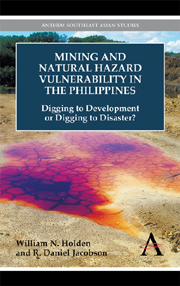 Mining and Natural Hazard Vulnerability in the Philippines
Mining and Natural Hazard Vulnerability in the Philippines Book contents
- Frontmatter
- Contents
- Acknowledgments
- List of Tables and Figures
- List of Acronyms
- Introduction
- Chapter One Mining in the Philippines
- Chapter Two Government Efforts to Encourage Mining
- Chapter Three Environmental Effects of Mining
- Chapter Four Mining amid Natural Hazards
- Chapter Five Technocratic Responses to the Risks
- Chapter Six Risk Society in the Philippines
- Chapter Seven Mining as a Flawed Development Paradigm
- Chapter Eight Is Another World Possible?
- Conclusion
- Bibliography
- Index
Introduction
Published online by Cambridge University Press: 05 May 2012
- Frontmatter
- Contents
- Acknowledgments
- List of Tables and Figures
- List of Acronyms
- Introduction
- Chapter One Mining in the Philippines
- Chapter Two Government Efforts to Encourage Mining
- Chapter Three Environmental Effects of Mining
- Chapter Four Mining amid Natural Hazards
- Chapter Five Technocratic Responses to the Risks
- Chapter Six Risk Society in the Philippines
- Chapter Seven Mining as a Flawed Development Paradigm
- Chapter Eight Is Another World Possible?
- Conclusion
- Bibliography
- Index
Summary
Phenomenon under Study: Mining amid Natural Hazards
The last three weeks of November 2004 and first week of December 2004 were a tumultuous time for the Republic of the Philippines. From 14 November until 4 December 2004 the Philippines was visited by four serious weather events: Typhoon Yoyong, Tropical Storm Unding, Tropical Depression Violeta and Tropical Depression Winnie (Yumul et al. 2011). These weather events, and the resulting flash floods and landslides, inflicted havoc on the Philippines killing 1,068 people, injuring 1,163 and causing another 553 to go missing; collectively, these storms caused roughly PHP 7 billion (USD 125 million) worth of damage to crops and infrastructure and also threatened to disrupt the water supply of Metro Manila. When the final damage total was completed the overall damage of these storms was estimated at PHP 11.3 billion (USD 201 million).
On 1 December 2004, while these storms were ravaging the Philippines, the Philippine Supreme Court issued a historic ruling and reversed a decision it had made on 27 January 2004. In its 27 January 2004 ruling, the Supreme Court had invalidated some crucial provisions of the Mining Act of 1995 which allowed foreign corporations to own 100 percent of a mine located in the Philippines. This decision had complicated the efforts of the Philippine government to use large-scale mining as a development strategy.
- Type
- Chapter
- Information
- Mining and Natural Hazard Vulnerability in the PhilippinesDigging to Development or Digging to Disaster?, pp. 1 - 6Publisher: Anthem PressPrint publication year: 2012


